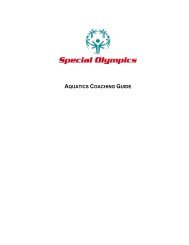BADMINTON Special Olympics Sports Skills Program
BADMINTON Special Olympics Sports Skills Program
BADMINTON Special Olympics Sports Skills Program
Create successful ePaper yourself
Turn your PDF publications into a flip-book with our unique Google optimized e-Paper software.
intervals. Build up to be able to perform the following<br />
workout sequence after a good warm-up and stretching<br />
period.<br />
• 3 minutes slow speed<br />
• 2 minutes medium speed<br />
• 1 minute fast speed<br />
Build up so you can repeat the above cycle three times for an<br />
excellent wo r kout specific to badminton fitness. Athletes should<br />
attempt to complete one fitness activity daily when not the<br />
same day as a team practice session and record what they did.<br />
Fitness Activity for Week # _____<br />
1.________________________________________________<br />
2.________________________________________________<br />
3.________________________________________________<br />
4.________________________________________________<br />
5.________________________________________________<br />
Signature of Athlete:___________________________<br />
Signature of Parent: ___________________________<br />
Mental Preparation<br />
Mental training is important for the athlete, whether striving to<br />
do his or her personal best or competing against others. Mental<br />
i m a g e ry, what Bruce D. Hale of Penn State University calls<br />
"No Sweat Practice," is ve ry eff e c t ive. The mind cannot tell the<br />
d i fference between what is real and what is imagined. Practice<br />
is practice, regardless of whether it is mental or phy s i c a l .<br />
Ask the athlete to sit in a relaxed position in a quiet place<br />
with few distractions. Tell the athlete to close his/her eyes<br />
and picture himself/herself performing a particular skill. Each<br />
athlete is seeing himself/herself on a large movie screen. Wa l k<br />
him or her through the skill step by step. Use as much detail<br />
as possible, using words to elicit the senses (sight, hearing,<br />
touch, and smell). Ask the athlete to repeat the image, to<br />
picture himself or herself rehearsing the skill successfully.<br />
Some athletes will need help beginning the process. Others<br />
will learn to practice this way on their own. The link between<br />
performing the skills in the mind and performing the skills in<br />
actuality may be hard to explain. However, the athlete who<br />
repeatedly imagines himself or herself correctly completing<br />
the skill and believing it to be true is more likely to make it<br />
happen. Whatever goes into the mind and the heart comes<br />
out in the athlete’s actions.<br />
4 4<br />
Cross-training Suggestions<br />
Cross-training is a good idea for badminton players as well<br />
as for all athletes. There are several sports that use some of<br />
the same skills and muscle groups as badminton. Fun<br />
activities such as bicycling, running, in-line skating, hiking,<br />
and walking can improve your overall fitness and thereby<br />
help your badminton game. <strong>Sports</strong> that use hand-eye<br />
coordination can improve badminton skills. Examples are<br />
baseball, tennis, squash, racquetball, fencing, and volleyball.<br />
The purpose of cross-training is to take part in activities that<br />
place similar demands on the body to badminton. However,<br />
training is sport specific. The advantage of cross-training<br />
activities is enhancing overall fitness and body management,<br />
not improving badminton specific fitness and skills.<br />
Nutrition Basics<br />
Nutrition influences performance. Athletes need these<br />
nutrients in their diets:<br />
C a r b o hy d ra t e s– are the primary energy source. 50-60<br />
percent of a daily diet should consist of bread, cereal, rice,<br />
pasta, potatoes, etc. Simple carbohydrates like suga r, candy,<br />
s y rup, etc., are high in calories but empty in nutritional va l u e .<br />
Fats– are a secondary energy source. 20-30 percent of the<br />
daily diet should come from primarily polyunsaturated<br />
(vegetable) sources.<br />
Protein– repairs and replaces cells and helps in regulating<br />
blood fluids. 10-20 percent of the daily diet should come<br />
from lean meat, fish, poultry, eggs, and dairy products.<br />
Vitamins– regulate growth and development and should<br />
come from a well-balanced diet.<br />
Minerals– regulate fluid exchange and should come from a<br />
well-balanced diet.<br />
Water– is one of the most essential of all nutrients. Drinking<br />
water before, during, and after events or training sessions<br />
helps to produce energy from the food we eat.<br />
Athletes should eat a meal at least 1.5 hours before a<br />
competition. This meal should be high in complex carbohydrates,<br />
yet low in proteins and fats. Baked potato, spaghetti,<br />
rice, and cereal all make good choices. A proper diet for<br />
i m p r oved athletic performance includes the follow i n g :<br />
• Eating a variety of wholesome foods<br />
• Eating a good breakfast<br />
• Chewing each bite of food thoroughly<br />
• Avoiding high-sugar foods such as cakes, cookies, and<br />
soft drinks

















